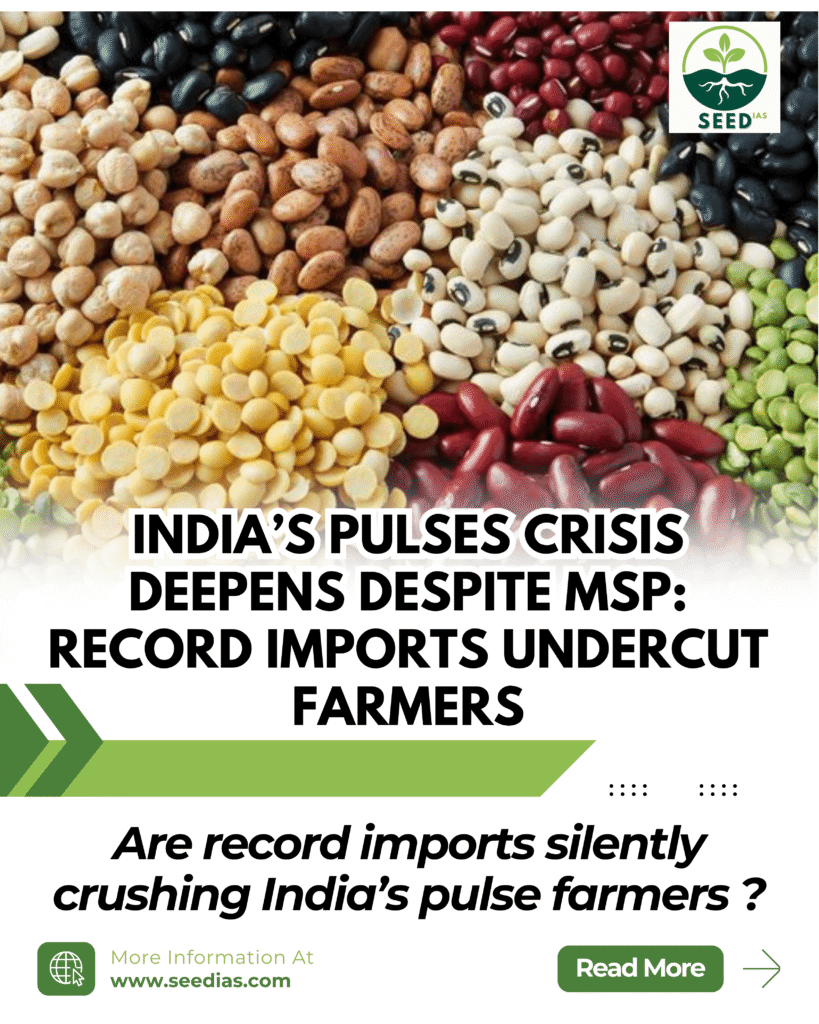Why in NEWS
Indian farmers are being forced to sell pulses below the Minimum Support Price (MSP) in the open market due to weak procurement mechanisms, even as India records its highest-ever imports of pulses, worsening the price crash for domestic producers.
Key Concepts and Terms
| Term | Explanation |
|---|---|
| Pulses | Dry edible seeds of leguminous plants such as gram, lentil, arhar, urad, and moong. Rich in protein and help in nitrogen fixation. |
| MSP (Minimum Support Price) | Government-declared price at which crops are bought from farmers to protect them from market fluctuations. |
| PM-AASHA | A scheme to ensure remunerative prices for farmers by improving procurement and price deficiency payments. |
| Rabi & Kharif Pulses | Rabi: Chana, Masoor. Kharif: Arhar, Moong, Urad — based on sowing and harvesting seasons. |
| Pulse Import | Purchase of pulses from other countries like Canada and Australia due to domestic shortfalls. |
| Yield (kg/ha) | Production per hectare of land. India’s pulses yield is lower than the global average. |
News Details
- MSP exists, but procurement fails: Farmers aren’t getting MSP due to lack of timely purchase by government agencies.
- Imports surge: India imported 7.3 million tonnes of pulses in 2024–25, worth USD 5.5 billion, exceeding previous records.
- Production drops: Pulses output fell due to El Niño-driven drought in 2023–24, recovering only slightly in 2024–25.
- Low prices in local markets: Imported pulses depress prices, pushing Indian farmers into distress despite growing more.
Reasons Behind Low Domestic Production and Farmer Distress
| Factor | Explanation |
|---|---|
| MSP & Procurement Bias | Favouring rice and wheat; inconsistent procurement discourages pulse cultivation. |
| Climate Dependence | Grown in rain-fed areas; sensitive to drought and extreme weather. |
| Low Yields | India’s average yield is 660 kg/ha (global average: 909 kg/ha). Poor seeds and lack of R&D. |
| Small Landholdings | Most pulse growers are marginal farmers, limiting investment capacity. |
| Pest & Soil Issues | Pulses attract pests and suffer from soil salinity and nutrient gaps. |
Current Government Initiatives for Pulses
| Initiative | Purpose |
|---|---|
| NFSM–Pulses | Increase productivity and area under pulses. |
| PM-AASHA | Support through Price Deficiency Payment and procurement. |
| RKVY | Fund state plans for crop diversification. |
| National Mission on Seeds | Promote high-yield and disease-resistant varieties. |
| NMSA | Sustainable agriculture practices for pulses in rain-fed areas. |
Measures Needed for Self-Sufficiency in Pulses
| Area | Actions Needed |
|---|---|
| Productivity Boost | Promote HYVs, hybrids, iron-rich lentils, precision farming. |
| Water & Land Use | Use rice fallows, promote micro-irrigation in key states. |
| Policy Reforms | Stronger MSP enforcement, incentives for crop diversification from rice to pulses. |
| Storage & Processing | Invest in silos, dal mills, fortification units. |
| Market Reforms | Empower FPOs, promote direct sales, control imports during surplus years. |
| R&D | More funding for early-maturing, climate-resilient pulse varieties. |
In a Nutshell (Mnemonic: PULSES FAIL)
Procurement gaps
Undervalued in subsidies
Low yields and poor R&D
Small farmers dominate
El Niño impact
Surging imports depress prices
FPOs and reforms needed
AASHA expansion critical
Infrastructure for storage
Legal MSP assurance pending
Prelims Practice Questions
- Which of the following is a Rabi pulse crop in India?
A. Moong
B. Urad
C. Arhar
D. Masoor - Which of the following schemes is specifically meant to support MSP implementation for pulses?
A. PM-KUSUM
B. PM-AASHA
C. PM-FMBY
D. PM-PRANAM - Which of the following countries is NOT a major exporter of pulses to India?
A. Myanmar
B. Brazil
C. Canada
D. Australia
Mains Practice Questions
- Examine the challenges faced by pulse farmers in India and suggest long-term policy reforms to make India self-sufficient in pulses. (GS III – Agriculture)
- Critically analyze the role of MSP and import policy in ensuring price stability for Indian pulse farmers. (GS III – Economic Development)
Answers to Prelims Questions
| Q.No | Answer | Explanation |
|---|---|---|
| 1 | D | Masoor is a Rabi pulse, grown in winter and harvested in spring. |
| 2 | B | PM-AASHA is a dedicated scheme for MSP enforcement, especially for pulses and oilseeds. |
| 3 | B | Brazil is not a significant pulse exporter to India; others like Myanmar, Canada, and Australia are. |
















